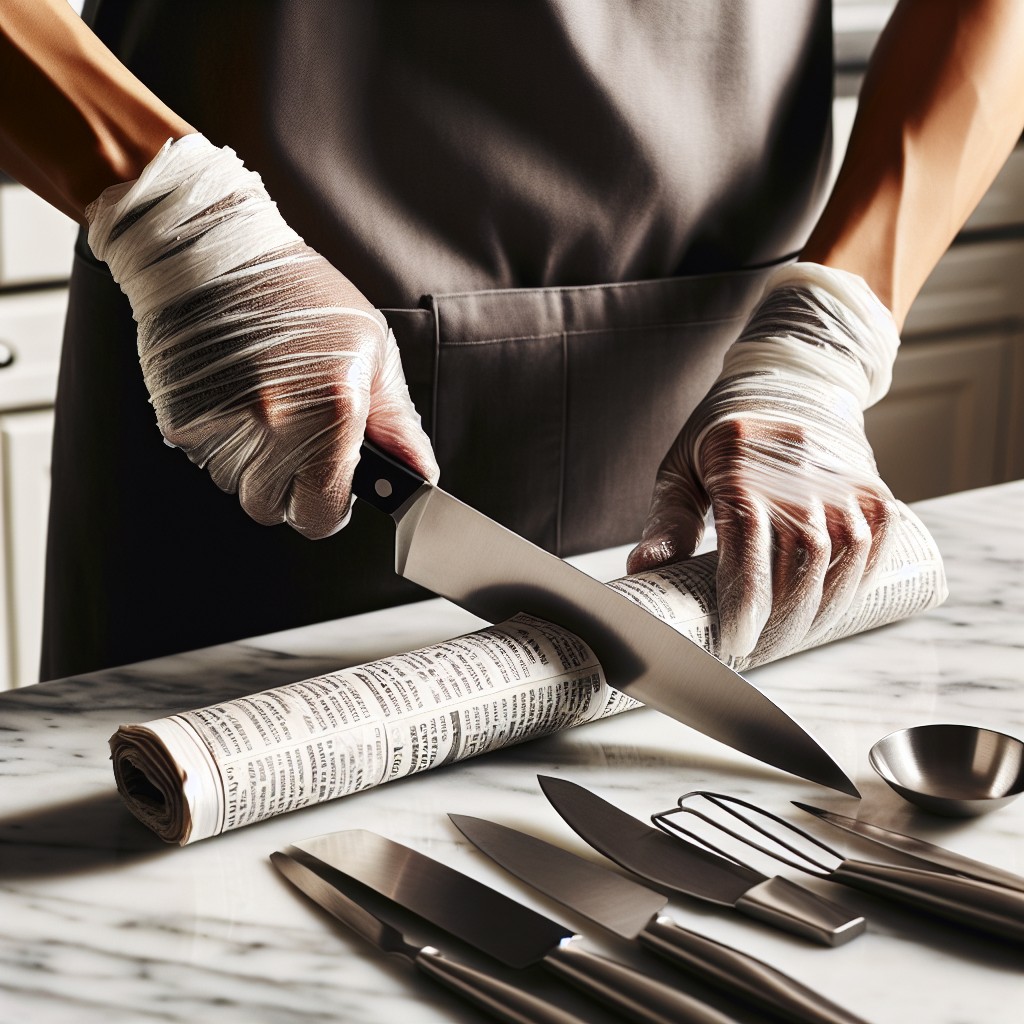Last updated on
Disposing of knives safely is essential to avoid injury and comply with local regulations; this article guides you through the proper steps to throw away knives without causing harm to waste handlers or the environment.
Key takeaways:
- Wrap Blades With Paper or Bubble Wrap
- Secure the Knife in Cardboard
- Check Local Recycling Centers for Knife Recycling Guidelines
- Donate Kitchen Knives to Second-Hand Stores or Shelters
- Follow Proper Steps for Discarding, Recycling, or Donating Knives
What's Inside
Wrap Blades With Paper

Securing the sharp edges is a priority to prevent injuries. Newspaper or bubble wrap works as an effective cushion. Begin by laying the knife on the paper, positioning it diagonally corner to corner. Fold the corners over the blade and roll until completely encased. Tape the bundle to secure it.
The goal is to ensure that the edge and tip won’t pierce through the material, keeping anyone handling the knives safe. If using bubble wrap, wrap multiple layers and tape all openings. Remember, the sturdier the covering, the safer the disposal process for everyone involved.
Secure the Knife in Cardboard
Once you’ve cushioned the blade with paper, further immobilize it by sandwiching it between two pieces of cardboard. Cut the cardboard slightly larger than the knife to ensure full coverage. Tape the cardboard pieces tightly together, encasing the knife completely.
This adds a sturdy layer of protection against accidents and prevents the knife from slicing through a garbage bag or injuring sanitation workers.
Always place the tip facing down towards the fold of the cardboard to minimize the chance of piercing.
Remember to use strong, wide tape like duct tape to keep the package secure, especially if handling larger or heavier knives.
This step is not just about safety; it’s about peace of mind for everyone involved in the disposal process.
Can You Recycle Kitchen Knives?
Metal kitchen knives can often find a second life through recycling; however, they aren’t typically accepted by curbside recycling programs due to their sharp nature and the potential harm to workers.
Instead, if your blades are still in shape, consider contacting scrap metal recyclers who may accept them for material recovery.
Local recycling centers sometimes offer specific guidelines for metals and can advise on drop-off procedures for such items.
Keep in mind, operation hours and accepted materials vary, so it’s best to check in advance.
It’s essential to ensure knives are safely wrapped and clearly labeled to prevent any accidents during the recycling process.
Remember, proper preparation is key to successfully recycling knives and contributing to sustainability efforts.
Can You Donate Kitchen Knives?
Donating kitchen knives is a worthwhile option. Often, second-hand stores, thrift shops, and shelters will accept them.
Before you donate, ensure the knives are in good condition, not excessively worn or damaged. Clean the knives thoroughly, removing any food particles or stains. This helps maintain hygiene and makes the knives more appealing to the next user.
Sharpening the knives is also a considerate touch, as it can extend the life of the knife and is safer for those handling them after you.
Remember to call ahead to the chosen organization to confirm their acceptance policy for such items, as some might have specific requirements or may not take knives due to safety concerns.
Always transport them safely, using the wrapping and cardboard methods previously outlined, to protect both the knives and the people handling them.
Steps for Safely Discarding, Recycling, or Donating Knives
Ensure the blade is fully wrapped with a thick layer of newspaper, magazine pages, or bubble wrap. Use tape to secure the wrapping so it doesn’t come loose.
Place the wrapped knife inside a piece of cardboard. Fold the cardboard around the knife and tape it shut, creating a makeshift sheath that prevents the blade from piercing through.
Label the package with a warning such as “Sharp” to alert anyone handling the waste or recycling.
If choosing to recycle, check with your local recycling center if they accept metal knives. Since knives are typically made of steel, they can often be recycled with metals. However, always confirm first as policies vary.
For donation, ensure that the knives are in good condition. Thrift stores, shelters, or culinary schools often accept kitchen utensil donations. Call ahead to verify acceptance policies.
Before disposal, donation, or recycling, remove any plastic handles that are not recyclable. This can be done by unscrewing them or if necessary, cutting them off. Dispose of non-metal parts according to your local regulations.
Always check with your local waste management facilities for specific guidance, as they may have particular requirements or suggestions for knife disposal.




